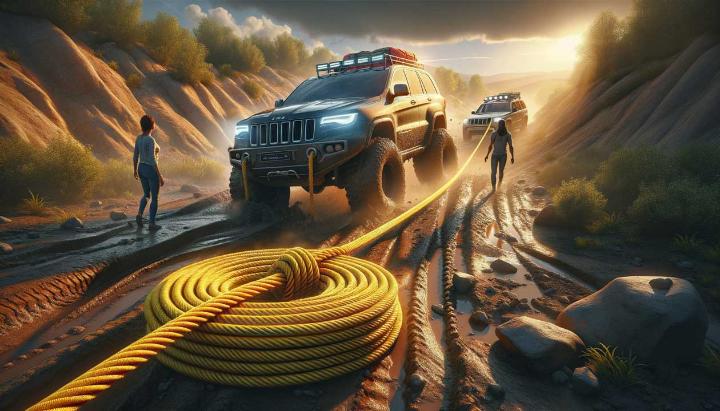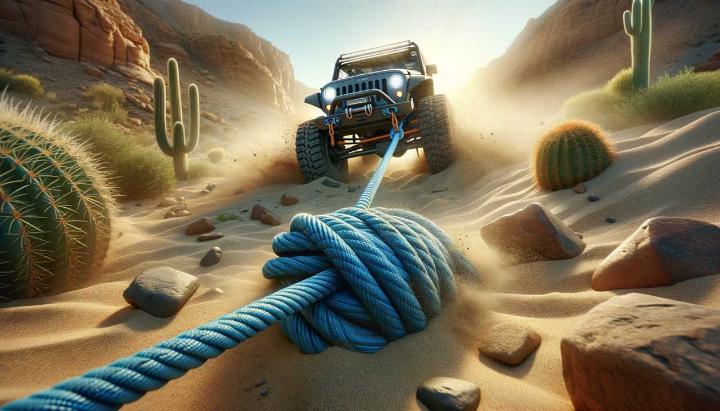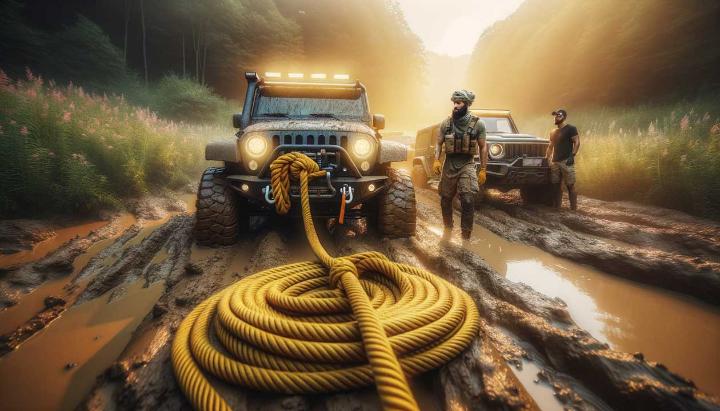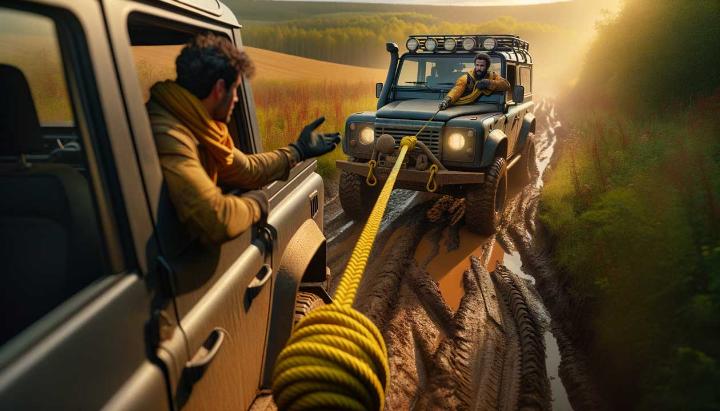Have you ever found yourself in a sticky situation while off-roading, desperately wishing for a reliable way to get your vehicle unstuck? Enter the kinetic energy recovery rope - a game-changer in the world of vehicle recovery that's revolutionising how we tackle tough terrain.
At iRopes, we've taken the humble tow rope and elevated it to new heights. Our nylon kinetic energy recovery ropes meet international standards and boast an impressive 30% stretch capacity. But why does this matter to you?
Imagine a rope that doesn't just pull, but propels your vehicle out of trouble. That's the power of kinetic energy at work. By absorbing and cushioning the dynamic forces during recovery, our ropes not only get you moving again but do so while prioritising your vehicle's safety.
In this ultimate guide, we'll delve into the world of kinetic energy recovery ropes, exploring their benefits, features, and why they're quickly becoming an essential tool for off-road enthusiasts and professionals alike. Whether you're a seasoned 4x4 veteran or new to the off-road scene, understanding the potential of these innovative ropes could be the difference between a minor setback and a major headache on your next adventure.
Ready to harness the power of kinetic energy and transform your vehicle recovery experience? Let's dive in and discover why our kinetic energy recovery ropes are the ultimate solution for conquering even the toughest terrains.
Understanding Kinetic Energy Recovery Ropes
If you've ever found yourself stuck in the mud during an off-road adventure, you know the importance of having the right recovery gear. Enter the kinetic energy recovery rope - a game-changer in vehicle recovery that's revolutionising the way we think about getting unstuck.
How Kinetic Recovery Ropes Work
Picture this: you're out on a trail, and your mate's 4x4 is bogged down in thick mud. Instead of reaching for a traditional tow strap, you grab your kinetic energy recovery rope. But what makes it so special?
Kinetic recovery ropes, also known as snatch ropes or yanker ropes, are designed to stretch up to 30% under load. This stretching ability is the key to their effectiveness. When the recovering vehicle accelerates, the rope stretches, storing kinetic energy like a giant rubber band. As it contracts, it transfers this energy to the stuck vehicle, providing a smooth, powerful pull that's less jarring than traditional methods.

Choosing the Right Kinetic Recovery Rope
Selecting the right kinetic recovery rope isn't just about picking the longest or strongest one. It's crucial to consider your vehicle's Gross Vehicle Mass (GVM) when choosing a rope. A rope that's too weak won't do the job, while one that's too strong could potentially damage your vehicle.
Here are some factors to consider:
- Rope strength: Generally, your rope's breaking strength should be 2-3 times your vehicle's GVM.
- Length: Most kinetic ropes are between 6-9 metres long, providing enough stretch for effective energy transfer.
- Material: Look for ropes made from high-quality nylon, known for its excellent stretch and durability.
Safe Usage and Best Practices
While kinetic recovery ropes are incredibly effective, they require proper handling to ensure safety. Always inspect your rope before use, checking for any signs of wear or damage. When setting up for a recovery, ensure all bystanders are well clear of the recovery zone - these ropes store a lot of energy, and a failure could be dangerous.
Remember, practice makes perfect. Why not organise a recovery day with your 4x4 club? It's a great way to familiarise yourself with your gear and build confidence in your recovery skills.
Always wear gloves when handling kinetic recovery ropes to protect your hands from potential rope burn or injuries.
In conclusion, kinetic energy recovery ropes are a valuable addition to any off-roader's toolkit. They offer a safer, more effective way to recover stuck vehicles, making them a must-have for your next adventure. So, are you ready to harness the power of kinetic energy on your next off-road trip?
Key Features of High-Quality Kinetic Energy Recovery Ropes
When it comes to off-road recovery, not all ropes are created equal. Kinetic energy recovery ropes stand out from the crowd, offering a blend of strength, flexibility, and safety that's hard to beat. Let's dive into the key features that make these ropes the go-to choice for seasoned off-roaders and newbies alike.
Material Composition and Durability
The backbone of any top-notch kinetic energy recovery rope is its material composition. Picture a rope that's not just strong, but also flexible and resilient - that's what we're talking about here.
- Double-braided nylon construction: This isn't your average rope. The double-braided design provides superior strength and durability, capable of withstanding the intense forces involved in vehicle recovery.
- UV-resistant properties: Sun damage is a real concern for outdoor gear. High-quality kinetic ropes are treated to resist UV rays, ensuring they don't degrade even after prolonged exposure to sunlight.
- Abrasion resistance: These ropes are built to handle rough treatment, resisting wear and tear from rocks, sand, and other abrasive surfaces you might encounter on the trail.

Stretch Capability and Energy Absorption
The magic of kinetic energy recovery ropes lies in their ability to stretch and absorb energy. This isn't just a party trick - it's the key to safer, more effective vehicle recovery.
- Up to 30% stretch: Unlike static ropes, kinetic ropes can stretch up to 30% of their length under load. This stretch is what allows the rope to absorb and store energy.
- Shock absorption: As the rope stretches, it absorbs the shock of the initial pull, reducing the risk of damage to both vehicles and making the recovery process smoother.
- Energy transfer: Once stretched, the rope releases its stored energy, providing an extra boost to help pull the stuck vehicle free.
I remember the first time I used a kinetic rope for recovery. The smooth, almost elastic feel of the pull was a revelation compared to the jarring yank of traditional tow straps. It felt like the difference between a gentle push and a sudden shove - and believe me, when you're stuck in the mud, that gentle push makes all the difference.
Safety Features and Ratings
Safety should always be your top priority when it comes to vehicle recovery. High-quality kinetic energy recovery ropes come with a range of features designed to keep you and your vehicle safe.
- Protective sleeves: Look for ropes with reinforced end loops, often covered with protective sleeves. These prevent wear and tear at the rope's most vulnerable points.
- Strength ratings: A good kinetic rope will have a clearly marked breaking strength. As a rule of thumb, choose a rope with a breaking strength 2-3 times your vehicle's Gross Vehicle Mass (GVM).
- Visibility features: Some ropes come with high-visibility colours or reflective threading, making them easier to see in low-light conditions.
Always check your kinetic energy recovery rope for signs of wear or damage before each use. A compromised rope can be dangerous in a recovery situation.
Choosing the right kinetic energy recovery rope is about more than just picking the strongest option. It's about finding the perfect balance of strength, flexibility, and safety features that match your vehicle and your off-road adventures. With the right rope in your recovery kit, you'll be ready to tackle whatever challenges the trail throws your way. So, are you ready to upgrade your recovery gear and experience the kinetic difference?
Choosing the Right Kinetic Energy Recovery Strap
When it comes to off-road adventures, having the right recovery gear can make the difference between a minor setback and a major headache. Kinetic energy recovery straps have revolutionised vehicle recovery, offering a safer and more effective solution than traditional tow straps. But how do you choose the right one for your needs? Let's dive in and explore the key factors to consider.
Understanding Kinetic Recovery Rope Sizing
Selecting the correct size for your kinetic energy recovery strap is crucial for both effectiveness and safety. Here's what you need to know:
- The 2-3 times GVM rule: As a general guideline, choose a kinetic rope with a breaking strength that's 2-3 times your vehicle's Gross Vehicle Mass (GVM). This ensures the rope can handle the forces involved in recovery without snapping.
- Length matters: Most kinetic ropes range from 6 to 9 metres in length. This provides sufficient stretch for energy absorption while maintaining control during recovery.
- Diameter considerations: The rope's diameter affects its strength and flexibility. Thicker ropes are generally stronger but less flexible, while thinner ropes offer more stretch but may have lower breaking strengths.
For example, if you're driving a mid-size 4x4 with a GVM of 3,000 kg, you'd want to look for a kinetic rope with a breaking strength between 6,000 kg and 9,000 kg. This provides the ideal balance of strength and flexibility for safe recoveries.
Using an undersized rope can lead to dangerous breakages, while an oversized rope may not stretch sufficiently to absorb kinetic energy effectively. Always prioritise safety by choosing the right size for your vehicle.
Key Features of Quality Recovery Straps
Not all kinetic energy recovery straps are created equal. Here are some essential features to look for:
- Material and construction: High-quality nylon is the gold standard for kinetic ropes. Look for double-braided construction, which offers superior strength and durability.
- Stretch capacity: The best kinetic ropes can stretch up to 30% of their length, allowing for optimal energy absorption and smooth recovery.
- Protective features: Reinforced eyes and protective sleeves help prevent wear and tear at the rope's most vulnerable points.
- Visibility: Bright colours or reflective threading can enhance safety during low-light recoveries.
When comparing kinetic ropes to traditional tow straps or snatch straps, the differences become clear. While a tow strap is designed for static loads and a snatch strap offers some stretch, a kinetic energy recovery rope provides superior energy absorption and a smoother, safer recovery process. Learn more about the key advantages of Yankum kinetic rope for a deeper understanding.

Remember, your kinetic energy recovery strap is an investment in your safety and peace of mind. Don't be tempted to cut corners on quality. A well-made rope from a reputable manufacturer might cost a bit more upfront, but it'll pay dividends in reliability and longevity.
Have you ever used a kinetic energy recovery strap in a tough situation? What was your experience like? Share your stories in the comments below - we'd love to hear how these amazing tools have helped you out of a sticky situation!
Best Practices for Using Kinetic Energy Ropes
When it comes to off-road adventures, knowing how to properly use your kinetic energy recovery rope can make the difference between a quick recovery and a potentially dangerous situation. Let's dive into the essential best practices that will keep you safe and get you back on the trail in no time.
Choosing the Right Kinetic Recovery Rope
Before we get into the nitty-gritty of usage, it's crucial to ensure you've got the right rope for the job. Remember, not all kinetic ropes are created equal!
- Size matters: Your rope's breaking strength should be 2-3 times your vehicle's Gross Vehicle Mass (GVM). For instance, if you're driving a 3,000 kg 4x4, look for a rope rated between 6,000-9,000 kg.
- Length considerations: Most kinetic ropes are 6-9 metres long, providing the perfect balance between stretch and control.
- Material quality: Opt for high-quality nylon ropes with double-braided construction for superior durability and performance. Discover more about our double braided nylon rope solutions.
I once made the mistake of using an undersized rope during a recovery, and let me tell you, it's not an experience I'm keen to repeat. The rope snapped under tension, creating a dangerous situation that could have been easily avoided with the right equipment.
Safe Usage Techniques for Kinetic Ropes
Now that you've got the right rope, let's talk about how to use it safely and effectively.
- Inspect before use: Always check your rope for signs of wear or damage before each recovery attempt.
- Proper attachment: Secure the rope to designated recovery points on both vehicles, never to tow balls or other non-rated attachments.
- Clear the area: Ensure all bystanders are at least 1.5 times the rope length away from both vehicles.
- Slow and steady: The recovery vehicle should accelerate slowly and smoothly to allow the rope to stretch and store energy.
- Communication is key: Use hand signals or radios to coordinate between drivers during the recovery process.

Remember, kinetic ropes are designed for recovery, not towing. After each pull, give the rope time to cool down and regain its elasticity. Continuous use without rest can compromise the rope's integrity and effectiveness.
Maintenance and Care of Kinetic Energy Ropes
Proper care of your kinetic energy rope will ensure it's ready for action when you need it most.
- Clean after use: Rinse your rope with fresh water to remove dirt and debris, then allow it to air dry completely.
- Store properly: Keep your rope in a cool, dry place away from direct sunlight when not in use.
- Regular inspections: Check for fraying, cuts, or other damage along the entire length of the rope. Learn about the importance of inspecting winch ropes as it applies similarly to kinetic ropes.
- Know when to retire: If you notice significant wear or damage, it's time to replace your rope. Safety first!
Pro tip: Consider keeping a log of your rope's usage. This can help you track its lifespan and know when it might be time for a replacement.
By following these best practices, you'll not only extend the life of your kinetic energy recovery rope but also ensure safer, more effective recoveries. Remember, practice makes perfect. Why not organise a recovery drill with your off-road mates? It's a great way to familiarise yourself with your gear and build confidence in your recovery skills.
Have you had any memorable experiences using a kinetic energy recovery rope? Share your stories in the comments below – we'd love to hear about your off-road adventures and lessons learned!
Kinetic energy recovery ropes have revolutionised off-road vehicle recovery by providing a safer, smoother, and more effective way to get unstuck. These ropes, known for their ability to stretch up to 30%, absorb and transfer kinetic energy, reducing the shock during recovery and protecting vehicle integrity. Key features of a high-quality kinetic energy rope include double-braided nylon construction for durability, UV resistance, and high visibility colours for added safety. When selecting a kinetic energy recovery strap, consider factors like your vehicle’s Gross Vehicle Mass (GVM), rope strength, length, and material quality to ensure optimal performance. Adhering to best practices, such as proper attachment, inspection, and maintenance, ensures safe and prolonged use of these indispensable tools. Whether you're a seasoned off-roader or a newbie, investing in a kinetic energy rope can make all the difference in your adventures.
Interested in Customised Kinetic Energy Recovery Ropes?
If you're ready to enhance your recovery gear with a top-quality kinetic energy recovery rope, fill in the inquiry form above, and our team will assist you in finding the perfect solution for your off-road needs. We offer ropes that meet international standards with up to 30% elongation, ensuring the safety and protection of your vehicle. Don’t miss out on making your next adventure safer and more enjoyable.